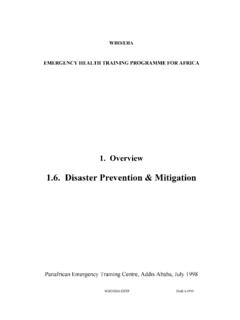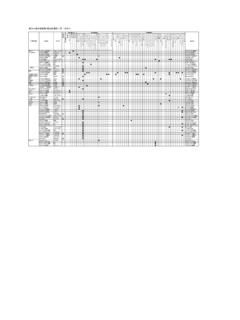Transcription of OpenGTS Installation and Configuration Manual
1 OpenGTS Installation and Configuration ManualCopyright 2007-2014 GeoTelematic Solutions, rights reservedOpenGTS Configuration and Installation Manual Page 1 of 62 Manual Revision information for 'User' table top-level ant targets for event, mologogo, and track servlet builds. Minor type changes, and paragraph/page format notes for Windows users. All command-line prompts in italic Added note about registering for a Google Map notes regarding support for Microsoft Virtual Earth. Added notes for Windows users regarding setting Installation environment MySQL download links. Include Ant download additional database administration documentation. Added note regarding installing a Perl interpreter on Windows. Fixed minor additional link for MySQL WinXP comments regarding JavaBeans Activation Framework Minor note changes. Additional comments regarding re-deployment of " ". Changed command name "server_mysql.*" to "server_dmtp.
2 *". reference to the creation of default account "opendmtp", device "mobile", when initializing the database with "initdb". Added commandswhich are equivalent to running "initdb". Added comments regarding customization of the " " servlet runtime configuation some additional comments regarding the 'Events' servlet. Table admin commands changed from "bin/admin<Table>.sh .." to " <Table> ..". DMTP server startup script changed to " -s gtsdmtp". comments regarding batch file use on Windows. Added notes regarding using 'template' and 'gprmc' for creating custom device additional note on using ' ' to add missing table columns. Minor text changes comment to prerequisites regarding the Installation of Tomcat on section on Internationalization/Localization. Added information regarding the implementation of device communication additional comments regardin Configuration of Tomcat on SDK is now required to build a section on Installation "Compile" section to include "ant all".
3 Added additional comments to Localization location of ' ' file. Updated the download link information for various additional comments regarding building the example 'template' note regarding 'bin\ ' command available for Windows users. Added information regarding customization of map minor the 'Database Administration' Apache Tomcat download Mac OS X Configuration information. Rearranged chapters. Added additional 'device communication server' start/stop section on installing notes regarding " " support for exporting GPX formatted events. Added section on "Creating/Modifying Reports". Added notes on validating LocalStrings additional comments regarding " " use for Google Earth map updates, note regarding customizing the loog-and-feel, comments regarding running " " on Windows. Updated Tomcat version to '-sendMail' option to 'checkInstall' informaton regarding 'runserver', starting/stopping device communication servers, and using 'psjava'.
4 Added information regarding the device communication servers runtime Configuration " " GTS system architecture section. Updated various pre-requisite links. Updated starting/stopping additional "Device" admin options. Added "Optional Table Columns" Prerequisite and OpenGTS installations into separate chapters. Renumbered chapters. Added additional information on the "gprmc" http-based device communication Trackstick CSV data import information ( ). Fixed minor typos, changes. Added JSON file format to " " description. Update JavaMail download Version/URL. Added information on starting the TK10x DCS table optional field Configuration and Installation Manual Page 2 of 62 OpenGTS Installation /ConfigurationContents: 1 Introduction Supported Platforms System Architecture Planned Enhancements Document Conventions 2 Loading the Prerequisite Modules Java Compiler JavaMail Support Apache "Ant" Build Tool Apache "Tomcat" Servlet Container MySQL Database Provider MySQL JDBC Driver 3 Installing/Compiling the OpenGTS Source Unzipping/Installing the OpenGTS Source Setting the Environment Variables Compiling the Supporting GTS Library Files 4 Initialization and Installation Testing Initializing the SQL Database Tables Testing the Installation Loading the Sample Data Creating the "sysadmin" Account 5 Installing Configuring the File Configuring the Available Reports Configuring the Private Label Look and Feel Compiling/Installing the Servlet Testing the Installation Installing Multiple Versions of " " 6 Installing Configuring the file Compiling/Installing the Java Servlet Testing the Installation 7
5 Database Administration Creating/Editing Accounts Creating/Editing Users Creating/Editing Devices General Database Administrative Functions 8 Installing/Starting the OpenDMTP, TK10x, and Aspicore DCS Modules Configuring the " " File Starting the Device Communication Server Stopping the Device Communication Server Adding a New Device Record 9 Creating Your Own Device Communication Server HTTP-Based Device Communication Servers (using the "gprmc" servlet) Configuring the "gprmc" Servlet Default "gprmc" Configuration Building the "gprmc" Servlet Raw Socket-Based Device Communication Server Starting the Device Communication Server Stopping the Device Communication Server Runtime XML Configuration FileOpenGTS Configuration and Installation Manual Page 3 of 62 OpenGTS Installation /ConfigurationContents: (continued) 10 Internationalization/Localization Supporting a New Language Changing the Displayed Language 11 Creating/Modifying Reports Report Layout.
6 Report Data Iterator Report Definition XML Available Report SpecificationsAppendix: A) Support for Microsoft SQL ServerB) Support for Mologogo Capable PhonesC) Optional Table ColumnsD) Installing MotoDMTPE) Importing GPS Events from the TrackStick MiniOpenGTS Configuration and Installation Manual Page 4 of 621) IntroductionOpenGTS (Open Source GPS Tracking System) is intended to provide a generic back-end web-based service for querying and viewing GPS related data. It is desgined to operate independently of any specific GPS tracking device or protocol, but comes with support for several device protocol formats (such as OpenDMTP - Open Source Device Monitoring and Tracking Protocol ).It is specifically designed for use in small to medium sized commercial enterprises wishing to take advantage of GPS tracking for "fleets" of vehicles. However, OpenGTS is highly configurable and scalable to larger enterprises as the server side, OpenGTS is designed to be device and protocol independent.
7 In order to use the features of OpenGTS , a specific device/protocol communication server will need to be implemented to communicate with the remote device and place the data in the SQL database. OpenGTS ships with support for OpenDMTP ( ) so that OpenDMTP compliant devices will be ready to immediately utilize the services of OpenGTS . A custom device communication server can also be implemented using the included example server source code. See the chapter titled "Creating Your Own Device Communication Server" for more the web-interface side, the user presentation is easily customizable to fit the individual desired motif. Menu options and features are also easily customizable to fit specific source code for the OpenGTS project may be downloaded from SourceForge at the following link: (Licensed under the Apache License Version 2: )DISCLAIMER: OpenGTS /OpenDMTP must not be used for any illegal activities. The providers of this project assume no responsibity for any illegal activities that may be conducted by users of this ) Supported PlatformsOpenGTS is completely implemented in Java and should run fine on any system that fully supports the Java Runtime Environment.
8 However, this implementation does require an SQL database server, and is therefore also limited to systems on which your chosen SQL database runs. See the respective SQL database support website for their supported systems (ie. for MySQL see " " which has been tested with OpenGTS on Linux, Mac OS X, FreeBSD, OpenBSD, and Windows-XP/Vista/20xx platforms). ) System ArchitectureThis graphic describes the basic system architecture of the OpenGTS system. The various device communication servers (the modules which listen for incoming data from the remote GPS tracking devices) run as separate processes on top of Java. The Track servlet (ie. The web-interface), as well as other servlets (including any http-based device communication server), run within a Servlet Container, such as Apache Configuration and Installation Manual Page 5 of ) Planned EnhancementsOpenGTS is always evolving, and new features are continually being made available. Here are some general categories of the features that are in the planning or implementation stage: Additonal map features.
9 Additional Enterprise was built on OpenGTS and has several additional features available as well (more information regarding the GTS Enterprise can be found at " "): Support for several commercial use mapping service providers. Support for many additional remote GPS tracking devices. Additional reporting options. Simple 'Rules' engine to send notifications based on criteria from incoming events (enhanced Event Notification Rules Engine is also available).Contact us regarding the availability of these and other features at Document ConventionsIn order to provide a generic Installation / Configuration document that covers various systems types (ie. Windows XP, Mac OS X, and the various Linux distributions), and the various versions of the OpenGTS system, the following conventions and assumptions have been adopted within this document:1)This document will assume that the target operating system is Linux-based. For other operating system types, the appropriate path separators and directory specifications will need to be used that match the requirements of your specific operating system.
10 Environment variable specification may also vary between operating systems. For instance, to de-reference the JAVA_HOME environment vairable, "%JAVA_HOME%" would be specified on a Windows system, while "$JAVA_HOME" is specified on Linux and Mac OS )This document will assume that the directory in which OpenGTS will be installed is "/usr/local/". If you will be installing OpenGTS in a different directory, you will need to replace the directory references in this documentto the directory in which OpenGTS was ) OpenGTS has a frequent release schedule. For consistency, this document will assume that the version of OpenGTS to be installed is " ". So references to " " within this document should be replaced with the actual name and version of OpenGTS that you will be )On various command line examples, you may see the directory specification "/zzz". This specification is simply a placeholder name representing some current directory on your system, and not a literal directory name existing on your )In various locations within this document, command-line options are specified as "-argName=value", where "argName" is the name of a command-line argument, and "value" is the value to be assigned to the command-ine argument.






